Peperomia lilian, home care, reproduction features
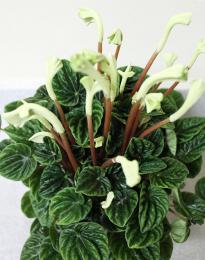
Peperomia - an indoor flower that reproduces very well at home. This indoor plant has a rather attractive appearance. It has small elastic, dense, fleshy leaves with a rather unusual color.
There are about 30 varieties of this plant that reproduce well. But this plant is not bred for the sake of beauty. flowering, but thanks to the diversity of its foliage.
The name of this flower is translated from Greek as “smelling pepper”, and is common to all tropical plants belonging to the family pepper. The flower got its name because of the leaves, which when rubbed produce a peppery smell. Peperomia Lilian is native to Mexico.
Let's talk today about Peperomia Lilian - its planting, care features, methods of reproduction, correct transplantation and pruning methods.
Content
- Description of the plant
- Amazing properties
- Features of care
- Transfer
- Reproduction methods
- Landing
- Pruning rules
- Pest Control
- What can result from improper care?
Description of the plant
Peperomia is a potted crop that prefers loose peat soil. When flowering, it produces snow-white buds that have an original appearance, to some extent reminiscent of lilies, expanding towards the top.
The flowers are located on powerful stems that are raspberry in color.They rise above the surface of the dense, dark green foliage during flowering. When the flowers fade, small, dry berries form on the top of the peduncles.
Peperomia Lilian - refers to evergreen shrubs, have a compact shape. The leaves of the flower are painted in a rich green color and their shape resembles a heart. It usually grows well in a pot and can reach sizes of up to 32 centimeters in width and height.
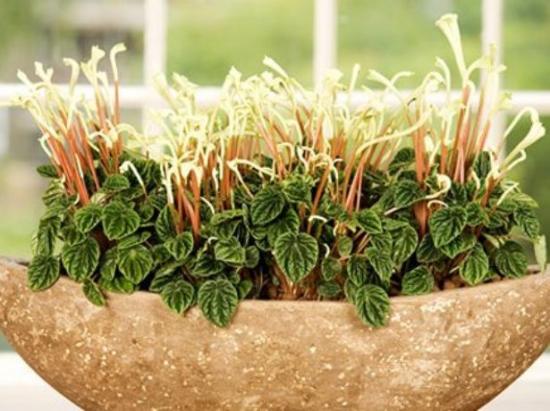
This variety is widely used to create overhead compositions. Pots with plants can be displayed on flat, horizontal surfaces or hung. Using your imagination, you can decorate any interior with this amazing plant.
Peperomia tolerates overdrying or waterlogging of the soil. Does not require frequent feeding. If you accidentally forget and do not water the plant for several days, it will survive the “dry period” just fine.
But every gardener who grows this flower should know the subtleties of caring for peperomia. After all, this affects the appearance of the plant and its well-being.
Amazing properties
Peperomia Lilian has a huge number of positive qualities. Scientists have proven that the flower has a positive effect on the digestive system and the atmosphere of the home in which it is located. The plant releases phytoncides in large quantities, which destroy pathogens, which helps restore the microclimate in the house.
It is also recommended to place it in rooms where there are children who often suffer from colds.
In addition, there is a claim that this flower helps restore positive energy in the home. He is able to put people who live next door to her in a positive mood. Thanks to the effects of the plant, people get a positive mood, and the negative aspects do not have a strong destructive effect on people.
When a visitor with evil intentions turns up in the house, Lillian's Peperomia takes the brunt of the blow. How do you feel after such a guest? flower may get worse for a while. You can restore the plant’s strength by giving it attention and care.
Features of care
The flower will grow more actively if it is placed on windowsillwhere it will not be exposed to direct sunlight. The most suitable place for peperomia would be to place it on windows facing east or west.
During the winter period, the plant needs to extend daylight hours with the help of additional lighting. The temperature of the air inside the room and the soil in the pot should be optimal and range from 16 to 22 degrees Celsius.
The plant needs moderately abundant and regular watering In spring and summer. But you shouldn’t get carried away with this, due to the fact that peperomia is much better able to withstand short-term drought than an abundance of moisture, which causes rotting of the roots and stems. To prevent possible waterlogging during transplantation, it is necessary to provide drainage.
Transfer
Young peperomias Lilian need to be replanted annually, but for adults one replantation every couple of years will be sufficient. The diameter of the new pot should be two centimeters larger than the previous one.At the same time, the container should be a little deeper.
The plant needs regular feeding complex fertilizers. In the spring-autumn period they need to be done once every two weeks, and in winter - once every four weeks.
Reproduction methods
Flower growers often breed one type of plant to create a miniature garden. It looks quite unusual when pots with one plant are placed throughout the room. Peperomia Lilian is popular because of its ease of care at home.
There are other varieties of peperomia that do not require care: magnoleaf, blunt-leaved, wrinkled.
The plant can be propagated in three ways: seeds, cuttings and leaves.
Growing from seeds
This is the most difficult way to propagate Peperomia Lilian, because at home this flower practically does not produce seeds. For this method of propagation, they must be purchased at a specialized store.
Purchased seeds it is necessary to spread it on the surface of soft soil, and cover the container with seedlings with glass on top to create greenhouse conditions. It is very important that the temperature is about 24 degrees and the humidity is optimal.
Seedlings must be watered through a tea strainer, because a large stream of water stops plant growth.
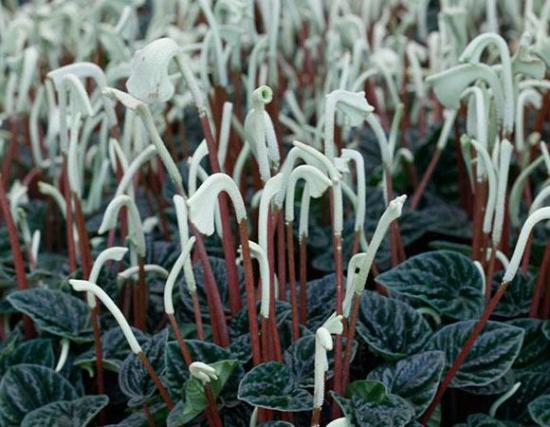 Young plants need to be picked when they reach the stage of two true leaves. Seedlings must be planted at a distance of at least 2 centimeters from each other. Then containers with seedlings should be placed on window sills in a pre-shaded area.
Young plants need to be picked when they reach the stage of two true leaves. Seedlings must be planted at a distance of at least 2 centimeters from each other. Then containers with seedlings should be placed on window sills in a pre-shaded area.
After strengthening, the seedlings can be planted in individual pots.
Propagation by cuttings
The upper part of the plant shoot or part of the stem, which has from 1 to 3 leaves, must be planted in moist soil, which includes earth, sand and peat. Leave the container with the seedling in a warm place for rooting.
It will take about a month for the root system to form. Then, if there were several seedlings, they need to be planted in separate pots.
Reproduction from leaf
Leaves of good quality - not limp, not damaged, must be placed for rooting in sandy-peaty soil and covered with a piece of glass on top to create greenhouse conditions. With this method of propagation, roots are formed much faster than with cuttings. After 12 days, the first roots appear, and by the end of 25 days, complete rooting occurs.
Landing
To plant Peperomia Lilian you do not need to use a large container, but be sure to lay a drainage layer about six centimeters thick. This indoor plant does not grow quickly. If growth slows down excessively, you need to carefully examine the bottom of the pot to see if the roots of the plant are visible there.
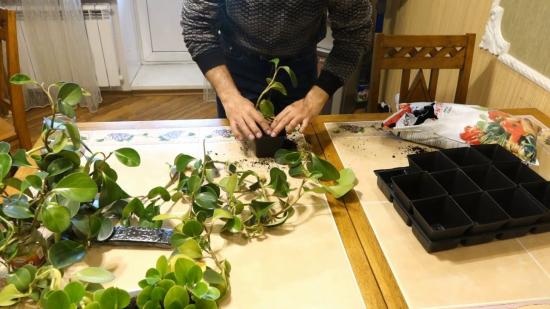
Fairly loose the soil - the key to proper flower development. A mixture of peat, sand and leaf soil, where all components are present in equal parts, is best suited.
Pruning rules
Trimming Peperomia Lilian is necessary to give it a beautiful appearance. It helps to increase bushiness and attractiveness. Before pruning It is necessary to carefully examine the plant, then use scissors to remove weak shoots and twigs. This type of care allows you to refresh the plant.
In addition, when pruning, flower growers sometimes remove inflorescences. This is done in order to preserve the strength of the flower.Mature plants tolerate pruning with difficulty.
For this reason, the flower crown must be formed before the age of 2-3 years.
Pest Control
Peperomia is resistant to various diseases. The main problems arise due to improper care of the plant. Weakened leaves and shoots of the plant are susceptible to insect damage -
If improper care procedures are carried out, the appearance of mealyworms, nematodes, mites or scale insects is inevitable. If symptoms of the presence of harmful insects It is urgent to take measures aimed at their destruction. It is necessary to treat with fungicides.
In addition, it is recommended to transplant the plant into steamed soil. The flower requires special attention and care. Be sure to follow the recommendations related to caring for this amazing flower.
Thanks to this, the plant will be able to restore its strength and will again delight with its splendor and beauty.
What can result from improper care?
The plant loses its protective abilities due to improper care. At the same time, it is affected by various diseases and pests. The negative factors that caused such changes can be judged by the appearance of the flower.
When leaves fall, the plant lacks moisture. This can occur at low temperatures in the room where the peperomia is located.
When they appear on the leaves spots brown color, the plant must be protected from drafts. In addition, the leaves darken as a result of temperature changes. Transporting plants open ensures that brown spots will soon appear on the leaves.
Rotting of the roots and blackening of the leaves indicate excessive watering.
Direct sunlight on the plant causes the foliage to yellow. Sometimes burns appear on it.
A flower can die if active actions are not taken to save it. For this reason, attention to proper care is required.
About the details of caring for the plant - in the video:

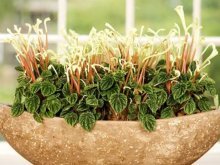
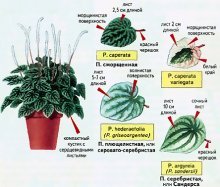
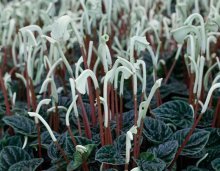
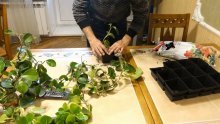

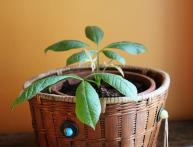
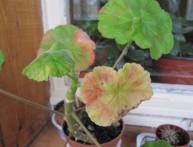



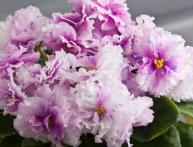
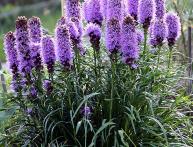
Comments
Interesting shaped flowers. I've never seen anything like it before. It vaguely resembles cyclamen. It’s suitable for my windowsill, which doesn’t get much sun. Where else can I find a leaf for propagation?